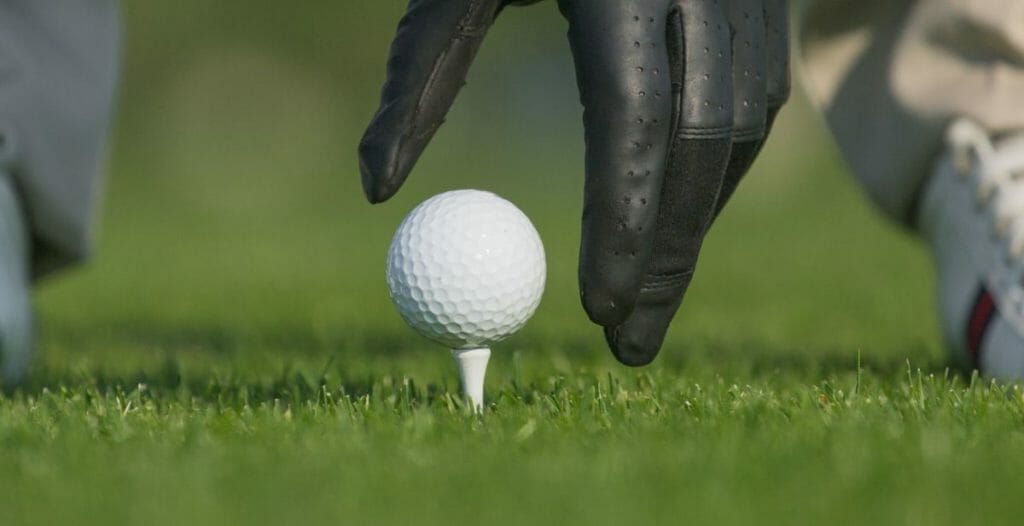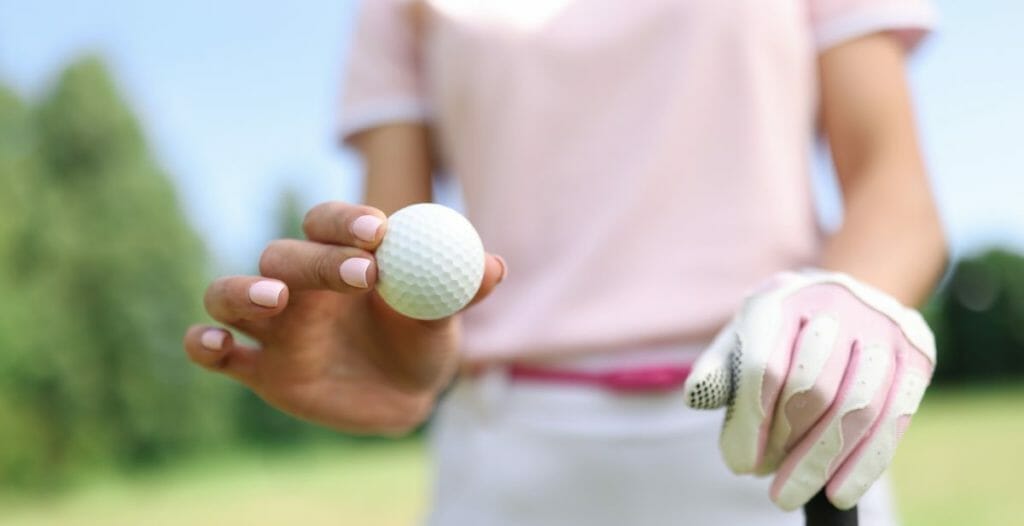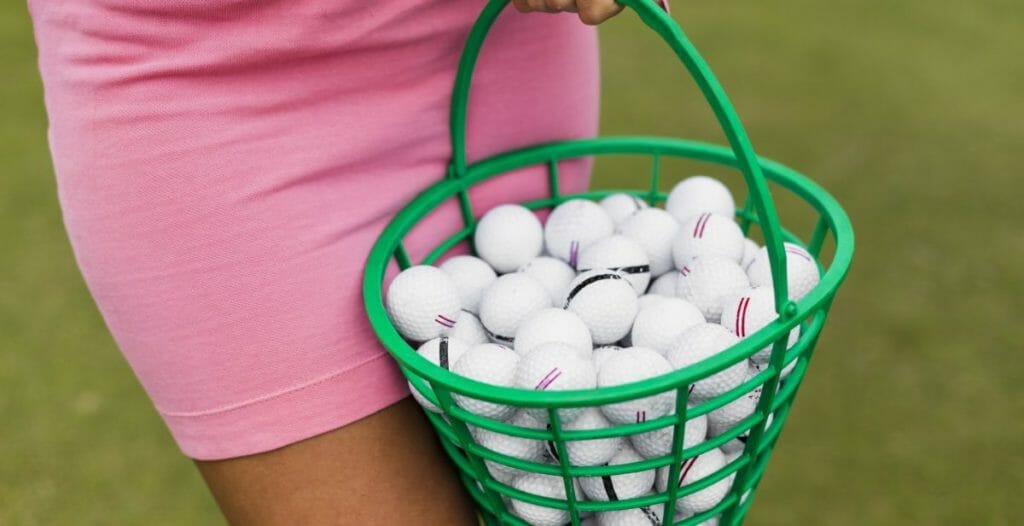In the grand scheme of the golf universe, questions like “how many dimples are on a golf ball” or what golf ball should I use are as crucial as mastering the swing itself.
This blog post aims to answer one such question by delving into the intricate world of golf ball aerodynamics.
Prepare to be surprised as we uncover the secrets behind this seemingly simple yet crucial aspect of golf ball construction.
The Origins of Dimples on Golf Balls: Limitations of a Smooth Golf Ball

The introduction of dimples on golf balls marks a significant milestone in the history of golf ball design, as it revolutionizes how the game is played.
In the early days of golf, golf balls were made of hardwood, such as beech or boxwood, and had a smooth surface. These solid, wooden, and smooth golf balls were effective for the relatively low-speed swings of the time.
However, as golfers started to develop more powerful swings and seek greater distance, the limitations of a smooth golf ball became apparent.
The breakthrough came when golfers realized that dimples on a golf ball helped reduce drag. When a golf ball is in flight, the air flowing over the ball’s surface creates a layer of turbulent air called the boundary layer.
The dimples disrupt this layer, causing the airflow to cling to the ball’s surface for a longer distance, thereby reducing drag.
Understanding Dimple Dynamics: How Golf Ball Dimples Work
To truly understand the importance of golf ball dimples, we must delve into the aerodynamic principles behind their design:
- Disruption of Air: When a golf ball is hit, it disrupts the air in its path, causing the air pressure in front of the ball to increase and the air pressure behind it to decrease.
- Creation of Drag: This pressure difference creates drag, which slows the ball down.
- Role of Dimples: The ingenious design of dimples on a golf ball serves to counteract this phenomenon. By creating turbulence in the layer of air closest to the ball’s surface, dimples reduce the pressure difference and consequently, the drag on the ball.
- End Result: The end result is a ball that flies further than it would have if its surface were smooth.
Smooth Golf Balls vs. Dimpled Golf Balls
To understand this better, let’s compare the performance of a smooth ball to a dimpled one:
- Smooth Golf Ball: Imagine hitting a smooth golf ball. The absence of dimples would lead to higher air pressure differences. Thus, a smooth golf ball hit even by a professional will have more drag, causing the ball to travel a shorter distance.
- Dimpled Golf Ball: In stark contrast, a dimpled ball, with its ability to reduce drag and travel further, became the standard in golf ball design.
Here, the principle of how to drive a golf ball far and straight becomes highly relevant as the design of the golf ball itself influences the game’s outcome.
The Exact Number of Dimples to Influence A Golf Ball’s Performance Characteristics

Initially, golf balls had around 300 to 400 dimples, but this number has increased over time.
Various factors, including aerodynamic considerations, design choices, and performance goals, influence the number of dimples on a golf ball.
Variation in Dimple Counts
Different golf ball manufacturers employ varying dimple patterns to achieve specific performance characteristics. While there is no definitive standard for the number of dimples on a golf ball, certain dimple count ranges have become prevalent within the industry.
When understanding different variations, you may be curious about what those numbers on golf balls mean and how they are related to their construction.
Factors Influencing Dimple Counts
- Aerodynamic Efficiency: Manufacturers conduct extensive testing and research to determine the ideal dimple configuration that maximizes the ball’s aerodynamic efficiency. The dimple count is often optimized to balance the golf ball’s lift generation, drag reduction, and overall stability.
- Ball Speed and Trajectory: Golf balls with lower dimple counts may generate higher ball speeds due to reduced drag, resulting in a flatter trajectory. In contrast, higher dimple counts can create more lift, allowing the ball to achieve a higher trajectory and potentially longer carry distances.
- Brand Identity and Performance Goals: Dimple counts can vary among brands to differentiate their products and provide unique performance characteristics. Some brands prioritize distance, while others focus on control or a specific playing style.
Common Dimple Counts by Brand
Different golf ball brands offer a variety of dimple counts across their product lines. Let’s take a closer look at the dimple counts of the most popular golf balls from major golf ball brands:
- Titleist: Titleist golf balls feature dimple counts ranging from 328 to 376, with variations across their ProV1, ProV1x, Tour Soft, AVX, and TruFeel models.
- Bridgestone: Bridgestone golf balls have dimple counts between 326 and 372, with different models like the Tour B330, e6, and Laddie Extreme falling within this range.
- Callaway: Callaway golf balls consistently feature a dimple count of 322 across their models.
- TaylorMade: TaylorMade golf balls offer dimple counts of 322, 342, and 360, depending on the specific model.
- Maxfli: Maxfli golf balls exhibit dimple counts ranging from 318 to 422 across their various models.
- Mizuno: Mizuno golf balls utilize unique micro-dimple patterns, with dimple counts of 360 and 566 on their RB Tour and RB 566 models, respectively.
Each brand aims to maximize the performance characteristics of their golf balls. As such, it’s essential to know how to clean golf balls properly to maintain their intended design features and maximize their lifespan. You might be surprised to find out how long golf balls last with proper care!
How Do Manufacturers Count Dimples on Golf Balls?

Manufacturers count dimples on golf balls through automated processes and sophisticated machinery. The exact method may vary slightly among manufacturers, but the overall process involves the following steps:
- Image Capture: High-resolution cameras capture images of the golf ball’s surface, focusing on a specific area where dimples are present.
- Image Analysis: Advanced software analyzes the captured images to detect and identify individual dimples. This analysis involves algorithms that distinguish dimples from other features on the ball’s surface.
- Counting and Verification: The software counts the number of dimples detected in the analyzed area. Manufacturers may employ quality control measures to ensure accurate counts, such as cross-referencing with multiple images or manual verification.
- Extrapolation: Once the number of dimples in the analyzed area is determined, manufacturers extrapolate this count to estimate the total number of dimples on the golf ball. This extrapolation is based on the assumption that the dimple pattern is consistent across the entire surface.
Rules or Regulations Regarding Dimple Counts in Golf

Regulation balls must have a minimum diameter of 1.68 inches (42.67 mm) and a maximum weight of 1.62 ounces (45.93 grams). This allows golf ball makers the flexibility to innovate and optimize their golf ball weights, designs, and sizes.
Final Words

As you expand your understanding of golf and its intricacies, you’ll find that the more you know, the more you can unlock your true potential.
From learning how to put backspin on a golf ball to stopping the habit of pulling the golf ball, each new technique or piece of knowledge can revolutionize your gameplay.
So, keep exploring, keep practicing, and keep striving to improve. The world of golf is rich with fascinating facts, tips, and techniques that can elevate your game.
Stay curious, and never stop learning!
